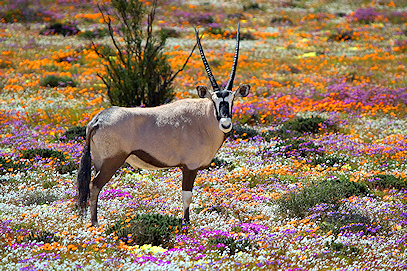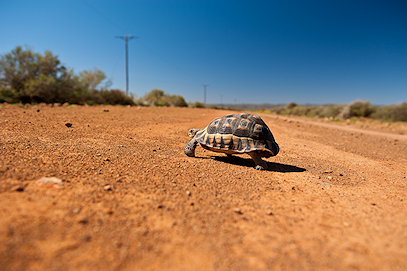South Africa's Namaqua National Park
Help Me Plan- Home
- >
- African Travel
- >
- South Africa
- >
- National Parks
- >
- Namaqua National Park
Namaqua National Park Destination Guide
The Namaqua National Park lies about 495 kilometers north of Cape Town near the small town of Kamieskroon. Celebrated for spring wildflowers that blanket the semi-desert after winter rains, it also offers coastal dunes, short trails, picnic sites, and hardy wildlife. Visitors typically combine the park with West Coast or Northern Cape itineraries.
Getting There
By Air: The park is situated on the sparsely populated West Coast of South Africa. Guests will fly to either Cape Town International Airport or Upington Airport. Most guests will visit the park after visiting other destinations, but if it is your first destination, a charter flight to a private airstrip in Springbok, approximately 70km from the park, is the quickest way to get there.
By Road: Namaqualand is almost 500km from Cape Town and 430km from Upington. Most guests prefer driving from Cape Town and stopping at quaint seaside retreats on the West Coast en route to the park. The drive from Upington embraces the Kalahari's beauty and the Karoo's northern reaches. When booking with African Sky, we will transport you in a private air-conditioned vehicle.
Weather & Best Time To Visit
Late winter rainfall typically arrives from May to August, with peak wildflower displays most often in August and September when conditions align. Summer can be hot in this semi-desert, but coastal fog moderates temperatures. Winters are mild by day and cold at night; pack warm layers for mornings and evenings.

There are some short nature trails and picnic spots in this area. On a walk in the area, you may encounter the Namaqua speckled padloper - the smallest tortoise in the world. The fauna in the Namaqua National Park is hardy and well adapted to the harsh environment. The park is also home to several antelope species and many bird species.
Reasons to visit Namaqua National Park
Dainty Daisies
Although the Namaqua National Park hosts a wide diversity of flora, the Namaqualand Daisy is a favorite among the floral kingdom's visitors. Daisies range from orange and yellow hues to striking white; the daisy grows everywhere in the Namaqualand after good rains.
Walking Trails
It is impossible to properly immerse oneself in the floral carpet when looking at it from afar. The various hiking trails are the best way to get close to the flowers that suddenly bloom all over the landscape during spring. Please refrain from making "flower angels," as many previous visitors have done – the vegetation needs protection.
Endangered Quivers
Amidst the beautiful flower carpet covering the area in multicolored magic, giant quiver tree dot the landscape. The giant quiver tree is Critically Endangered in parts of its range and occurs naturally in a small area. One reason it is so threatened is that it falls prey to plant collectors.
Experiences to Savor at Namaqua National Park
The Namaqua National Park is one of the most sought-after floral destinations in the world. Savor the unique nature of this flower utopia and its fascinating inhabitants.

Appreciating the Natural World
Flower power. Experience the magnificence of the Namaqualand in spring as the flowers bloom. There is no place like this on earth, and the endemic plants show off spectacularly. The multicolored floral blanket will keep you enthralled.
Coastal Dunes Break
As you continue west along the floral path, the vegetation starts to thin, and you reach the dunes. A picnic or a light brunch at the beautifully constructed facilities here will allow you to process the beauty of the Namaqualand and savor a sense of spiritual peace.
Look Down
Several animals and reptiles call the park home; of these, the tent tortoise is probably the most famous because of its endangered status. Be observant – you will be pleasantly surprised at the amount of life the park sustains.Useful Information
History
Namaqua National Park was officially proclaimed in 1999. Conservation in the area started in 1988 when WWF-SA purchased a part of the Skilpad Farm to conserve wildflowers. By 2004, work began on a proposed corridor to the coast. In 2005, negotiations started with De Beers Namaqualand Mine to eventually acquire the Groen-Spoeg River section of the national park by 2008.
The park is named after the Khoikhoi people of the area. "Nama" is the name of the area that they are originally from, and the suffix "qua" means "people." They were Iron Age pastoral herders that replaced the Stone Age San (Bushmen) hunter-gatherers that previously inhabited this area.
Wildlife
The park is home to many smaller mammals, such as rodents, insectivores, hares, cats, and small antelope. The little steenbok, the agile common duiker, and gangs of meerkat occur here. Four-striped grass mouse and round-eared elephant shrew constantly run between shrubs. Cunning black-backed jackal survey the surroundings daily, and nocturnal insectivores like bat-eared fox, aardvark, aardwolf, and Cape fox own the night. Chacma baboon occur, and if you visit the coastal section, you may encounter rookeries of the Cape fur seal. Caracal and African wild cat reside here, and Cape mountain leopard occasionally traverse the park.
Rodents attract various raptors, such as rock kestrel, black-shouldered kite, black harrier, and many more. Desert birds, like the cinnamon-breasted warbler, attract birders from far and wide. Reptiles are plentiful, and the protection of angulate tortoise and speckled padloper is a top priority.
Vegetation & Terrain
Namaqualand is famed for being a biodiversity hotspot with the largest concentration of succulents in the world. It is a semidesert with vegetation belonging to the succulent Karoo biome, north-western mountain renosterveld, and Namaqualand broken veld. The area has undulating plains extending to the Kamiesberg Range mountains. When the flowers bloom in a wide array of colors in spring, the plains seem even to put the majestic mountains to shame.
The succulent Karoo biome for which the area is known can be divided into the strandveld succulent Karoo, lowland succulent Karoo, and succulent upland Karoo. Unfortunately, a tiny percentage of this biome is formally protected.
Activities
Namaqualand is synonymous with flowers. After the annual winter rains, the usually arid Namaqualand transforms into a magical wonderland as a mass of flowers blossom. Carpets of orange, yellow, and purple flowers cover the expanse. The most popular activity is walking or driving around with a "Wow" erupting every few minutes. The circular drive is excellent for flower viewing and offers scenic viewpoints along the way. If you prefer to walk, the Silver Sands Trail is for you; here, hikers experience both oceanic and floral views.
The park offers a multitude of other attractions and activities. The area is well-known for its excellent mountain biking terrain and birding opportunities. Guests can also drive through the park in search of the unique animals that reside in the area; the speckled padloper (the world's smallest tortoise) and the angulate tortoise are endemic to the area. Various 4x4 eco-routes exist, and opportunities for landscape and wildlife photographers and cinematographers are endless.









